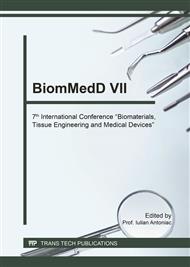p.81
p.87
p.93
p.99
p.105
p.111
p.119
p.126
p.132
Failure Modes of the Biometallic Materials - Case Study
Abstract:
Hip fractures/arthrosis were, still are and will be a challenge for the orthopedic surgeon. In this paper we conducted a case study on a rod used for hip replacement due to coxartrosis. The implant was used for hip replacement for NC patient aged 82 years. After twelve months the patient returns for the ablation of osteosynthesis material. Clinical and strengthen the fracture hip is found radiologic hypertrophic and degradation plaque. It was used a rod implant, on which were made following investigations in order to establish the causes that led to the fracture, namely: determining the chemical composition through spectral analysis, analysis macrostructural in stereo, microstructural analysis optical microscope metallographic respectively analysis fractogr aphic electron microscope streak. Complex analysis of the fracture surfaces of the hip prosthesis has led to the ultimate conclusion that the material has been made the hip prosthesis is inadequate chemical purity satisfactory embedding, which has led to breakage within an area of non-homogeneous structure.
Info:
Periodical:
Pages:
111-116
Citation:
Online since:
August 2017
Authors:
Keywords:
Price:
Сopyright:
© 2017 Trans Tech Publications Ltd. All Rights Reserved
Share:
Citation:


